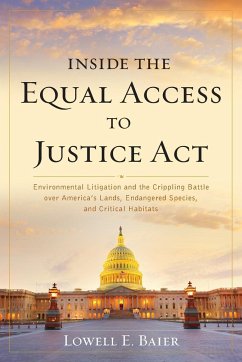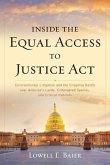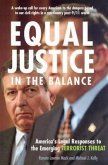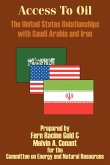Lowell E. Baier
Inside the Equal Access to Justice Act
Environmental Litigation and the Crippling Battle over America's Lands, Endangered Species, and Critical Habitats
Lowell E. Baier
Inside the Equal Access to Justice Act
Environmental Litigation and the Crippling Battle over America's Lands, Endangered Species, and Critical Habitats
- Broschiertes Buch
- Merkliste
- Auf die Merkliste
- Bewerten Bewerten
- Teilen
- Produkt teilen
- Produkterinnerung
- Produkterinnerung
Next Generation INDIE Book Awards Grand Prize Winner, Best Non-Fiction Book in 2017; and Winner in the Science/Nature/Environment category Finalist for Foreword INDIES Book of the Year Awards in Ecology and Environment In this book, Lowell E. Baier, one of America's preeminent experts on environmental litigation, chronicles the century-long story of Americas' resources management, focusing on litigations, citizen suit provisions, and attorneys' fees. He provides the first book-length comprehensive examination of the little-known Equal Access to Justice Act (EAJA) and its role in environmental…mehr
Andere Kunden interessierten sich auch für
![Inside the Equal Access to Justice ACT Inside the Equal Access to Justice ACT]() Lowell E BaierInside the Equal Access to Justice ACT108,99 €
Lowell E BaierInside the Equal Access to Justice ACT108,99 €![The Millennium of Peace and the Uplift of the Nations of the World for Justice and Equal Liberty to all the People of the World The Millennium of Peace and the Uplift of the Nations of the World for Justice and Equal Liberty to all the People of the World]() James Michael CordrayThe Millennium of Peace and the Uplift of the Nations of the World for Justice and Equal Liberty to all the People of the World28,99 €
James Michael CordrayThe Millennium of Peace and the Uplift of the Nations of the World for Justice and Equal Liberty to all the People of the World28,99 €![Access to International Justice Access to International Justice]() Access to International Justice190,99 €
Access to International Justice190,99 €![Hon. Roscoe Conkling: The Statesman, Orator, and Jurist, and The Advocate of Freedom - Humanity - Justice - Equal Rights! Hon. Roscoe Conkling: The Statesman, Orator, and Jurist, and The Advocate of Freedom - Humanity - Justice - Equal Rights!]() AnonymousHon. Roscoe Conkling: The Statesman, Orator, and Jurist, and The Advocate of Freedom - Humanity - Justice - Equal Rights!26,99 €
AnonymousHon. Roscoe Conkling: The Statesman, Orator, and Jurist, and The Advocate of Freedom - Humanity - Justice - Equal Rights!26,99 €![Equal Justice in the Balance Equal Justice in the Balance]() Raneta Lawson MackEqual Justice in the Balance39,99 €
Raneta Lawson MackEqual Justice in the Balance39,99 €![Answer Of The Hon. Honoré Mercier To The Pamphlet Of The Equal Rights Association Against The Majority Of The Inhabitants Of The Province Of Quebec Answer Of The Hon. Honoré Mercier To The Pamphlet Of The Equal Rights Association Against The Majority Of The Inhabitants Of The Province Of Quebec]() Honoré MercierAnswer Of The Hon. Honoré Mercier To The Pamphlet Of The Equal Rights Association Against The Majority Of The Inhabitants Of The Province Of Quebec28,99 €
Honoré MercierAnswer Of The Hon. Honoré Mercier To The Pamphlet Of The Equal Rights Association Against The Majority Of The Inhabitants Of The Province Of Quebec28,99 €![Access to Oil - The United States Relationships with Saudi Arabia and Iran Access to Oil - The United States Relationships with Saudi Arabia and Iran]() Fern Racine GoldAccess to Oil - The United States Relationships with Saudi Arabia and Iran27,99 €
Fern Racine GoldAccess to Oil - The United States Relationships with Saudi Arabia and Iran27,99 €-
-
-
Next Generation INDIE Book Awards Grand Prize Winner, Best Non-Fiction Book in 2017; and Winner in the Science/Nature/Environment category Finalist for Foreword INDIES Book of the Year Awards in Ecology and Environment In this book, Lowell E. Baier, one of America's preeminent experts on environmental litigation, chronicles the century-long story of Americas' resources management, focusing on litigations, citizen suit provisions, and attorneys' fees. He provides the first book-length comprehensive examination of the little-known Equal Access to Justice Act (EAJA) and its role in environmental litigation. Originally intended to support veterans, the disabled and small business, the EAJA, Baier argues, now paralyzes America's public land management agencies. Baier introduces readers to the history of EAJA, examines the many beneficiaries of the law, describes in depth 20 of the most prominent litigious environmental groups in America, and recommends carefully tailored amendments to the EAJA to correct environmental abuses of the law while protecting legitimate interests. Inside the Equal Access to Justice Act will be a valuable resource for the environmental legal community, environmentalists, practitioners at all levels of government, and all readers interested in environmental policy and the rise of the administrative state.
Produktdetails
- Produktdetails
- Verlag: Rowman & Littlefield Publishers
- Seitenzahl: 680
- Erscheinungstermin: 17. März 2020
- Englisch
- Abmessung: 229mm x 152mm x 36mm
- Gewicht: 968g
- ISBN-13: 9781538142776
- ISBN-10: 1538142775
- Artikelnr.: 58521089
- Herstellerkennzeichnung
- Libri GmbH
- Europaallee 1
- 36244 Bad Hersfeld
- gpsr@libri.de
- Verlag: Rowman & Littlefield Publishers
- Seitenzahl: 680
- Erscheinungstermin: 17. März 2020
- Englisch
- Abmessung: 229mm x 152mm x 36mm
- Gewicht: 968g
- ISBN-13: 9781538142776
- ISBN-10: 1538142775
- Artikelnr.: 58521089
- Herstellerkennzeichnung
- Libri GmbH
- Europaallee 1
- 36244 Bad Hersfeld
- gpsr@libri.de
By Lowell E. Baier
Table of Contents
Title Page
List of Illustrations
Prologue: Environmental Litigation and Its Consequences
Author's Acknowledgments
Chapter 1: The Growth of Government Regulation in the United States
The New Deal and the Foundation of the Administrative State
The Administrative Procedure Act and Control Over Agencies
Expanding Entitlements
The Great Society: Kennedy and Johnson
The Era of Public Interest Law: Civil Rights, Consumerism and
Environmentalism
Environmental Litigation and Broadening the Waiver of Sovereign Immunity
Chapter 2: The Development of the Equal Access to Justice Act
Early EAJA Proposals: Expanding the Public Interest Mandate
Narrowing and Focusing the Legislation: Responding to a Devastating
Economic Crisis and Bureaucratic Blitzkrieg
EAJA: The Evolution of a Unique Small Business Bill
The 1980 Presidential Election and the Reagan Revolution
Wisconsin's 1980 2nd District Congressional Election Campaign: A Microcosm
of the Presidential Election
The Voice of the Silent Majority: America's Small Business Community
Resonates Through the Presidential Election Campaign
1980 EAJA Hearings and Chairman Kastenmeier's Dilemma
The September 3-4, 1980 Mark-Up of EAJA S. 265: Resurrection of a Pariah,
the 501(c)(3) Financial Exemption
Paranoia in the Capitol: EAJA's Enactment Becomes Politically Pragmatic
Chapter 3: Use and Amendment of the Equal Access to Justice Act from 1981
to 1985
EAJA 101: How It Works
Moving EAJA from Temporary Legislation to Permanent Legislation
The Financial Exemption for 501(c)(3) Organizations
President Regan's Rejection of EAJA's Reauthorization
Chapter 4: Success and Expansion of the Equal Access to Justice Act After
1985
Expanding EAJA's Coverage and Reporting EAJA's Successes
Imitating EAJA
Successful Users of EAJA
Small Businesses
Veterans
Social Security Beneficiaries
Native Peoples
Immigrants
Exceptions: Cases Where EAJA Does Not Apply
Regulatory Shifts in the 1980's and 1990's
Further Amendments to EAJA
Chapter 5: The Universe of the Eco-Crusaders
The Constellation of Environmental Advocates
The First Generation: 1886 - 1936
The Second Generation: 1947 - 1970
The Third Generation: 1970 - 2000
Anthropocentric Versus Biocentric Man, and Deep Ecology
The Secret World of Animal Rights
Chapter 6: Barbarians at the Gate: Saints and Sinners
Profiles of the Third Generation's Eco-Warriors: 1970 - 2000
Environmental Public Interest Law Firms
Conclusion to a Century of Change
Chapter 7: The Environmental Litigation Crisis
The Endangered Species Act: A License to Sue
The Cost of Endangered Species
Megafauna to Megalitigation: Multidistrict Litigation
The MDL: Courtroom Access for Special Interests
A Temporary Reprieve: How the MDL will Beget More Lawsuits
An Answer to Litigation-Driven Species Management: Cooperative Conservation
Chapter 8: Cooperative Conservation: Preempting Listings and Building Trust
The Future Challenge: An Exercise in Trust
The Dunes Sagebrush Lizard
The Lesser Prairie Chicken
The Greater Sage Grouse
Cooperative Conservation and Greater Sage Grouse
Cooperative Conservation: An Endangered Future?
Chapter 9: Abuses of the Equal Access to Justice Act: Endangered Species
and Beyond
Armageddon: Litigating Solely to Delay Federal Agency Action
Of Wolves and Men: Using Litigation to Delay Delisting
EAJA and Endangered Species: Statutory Limitations on Attorneys' Fees
Provisions
501(c)(3)s and the Equal Access to Justice Act: America Foots the Bill
Evading Pierce: The Inflation of EAJA Fees
The Prevalence of Settlements
The Sue and Settle Gambit: A New Phenomenon
Rulemaking by the Courts and Environmentalists
The Cost of EAJA
Chapter 10: Reforming the Equal Access to Justice Act
Recent Scrutiny of EAJA
Congressional Scrutiny of EAJA
Recommendations for Future EAJA Reform
1. Restore reporting provisions
2. Ensure the award of reasonable attorneys' fees
3. Make judicial intervention mandatory
4. Strengthen eligibility requirements
5. Fees awards under EAJA should be limited to $200,000 in any single case
6. Each prevailing party should be limited to a total of three EAJA awards
in any given year
7. Parties should be statutorily barred from collecting multiple EAJA
awards for the same work
8. EAJA fees should be reduced in cases where parties utilize staff
attorneys rather than outside counsel
9. EAJA fees should be paid from agency budgets, not the Judgment Fund
10. End no-fault litigation: Reverse fee shifting should be available under
EAJA
A Time for Action
Epilogue: A New Beginning?
Bibliography
Appendix A: The Equal Access to Justice Act
Appendix A(1): The Equal Access to Justice Act After Passage in 1980
Appendix A(2): The Equal Access to Justice Act After Reauthorization in
1985
Appendix A(3): The Equal Access to Justice Act Today
Appendix B: EAJA Payments by the Department of Veterans Affairs, 2003-2012
Appendix C: EAJA Payments by the Social Security Administration, 2004-2012
Appendix D: Model Bill for Reform of the Equal Access to Justice Act
Appendix E: Acronyms
Bibliography
Author Biography
Title Page
List of Illustrations
Prologue: Environmental Litigation and Its Consequences
Author's Acknowledgments
Chapter 1: The Growth of Government Regulation in the United States
The New Deal and the Foundation of the Administrative State
The Administrative Procedure Act and Control Over Agencies
Expanding Entitlements
The Great Society: Kennedy and Johnson
The Era of Public Interest Law: Civil Rights, Consumerism and
Environmentalism
Environmental Litigation and Broadening the Waiver of Sovereign Immunity
Chapter 2: The Development of the Equal Access to Justice Act
Early EAJA Proposals: Expanding the Public Interest Mandate
Narrowing and Focusing the Legislation: Responding to a Devastating
Economic Crisis and Bureaucratic Blitzkrieg
EAJA: The Evolution of a Unique Small Business Bill
The 1980 Presidential Election and the Reagan Revolution
Wisconsin's 1980 2nd District Congressional Election Campaign: A Microcosm
of the Presidential Election
The Voice of the Silent Majority: America's Small Business Community
Resonates Through the Presidential Election Campaign
1980 EAJA Hearings and Chairman Kastenmeier's Dilemma
The September 3-4, 1980 Mark-Up of EAJA S. 265: Resurrection of a Pariah,
the 501(c)(3) Financial Exemption
Paranoia in the Capitol: EAJA's Enactment Becomes Politically Pragmatic
Chapter 3: Use and Amendment of the Equal Access to Justice Act from 1981
to 1985
EAJA 101: How It Works
Moving EAJA from Temporary Legislation to Permanent Legislation
The Financial Exemption for 501(c)(3) Organizations
President Regan's Rejection of EAJA's Reauthorization
Chapter 4: Success and Expansion of the Equal Access to Justice Act After
1985
Expanding EAJA's Coverage and Reporting EAJA's Successes
Imitating EAJA
Successful Users of EAJA
Small Businesses
Veterans
Social Security Beneficiaries
Native Peoples
Immigrants
Exceptions: Cases Where EAJA Does Not Apply
Regulatory Shifts in the 1980's and 1990's
Further Amendments to EAJA
Chapter 5: The Universe of the Eco-Crusaders
The Constellation of Environmental Advocates
The First Generation: 1886 - 1936
The Second Generation: 1947 - 1970
The Third Generation: 1970 - 2000
Anthropocentric Versus Biocentric Man, and Deep Ecology
The Secret World of Animal Rights
Chapter 6: Barbarians at the Gate: Saints and Sinners
Profiles of the Third Generation's Eco-Warriors: 1970 - 2000
Environmental Public Interest Law Firms
Conclusion to a Century of Change
Chapter 7: The Environmental Litigation Crisis
The Endangered Species Act: A License to Sue
The Cost of Endangered Species
Megafauna to Megalitigation: Multidistrict Litigation
The MDL: Courtroom Access for Special Interests
A Temporary Reprieve: How the MDL will Beget More Lawsuits
An Answer to Litigation-Driven Species Management: Cooperative Conservation
Chapter 8: Cooperative Conservation: Preempting Listings and Building Trust
The Future Challenge: An Exercise in Trust
The Dunes Sagebrush Lizard
The Lesser Prairie Chicken
The Greater Sage Grouse
Cooperative Conservation and Greater Sage Grouse
Cooperative Conservation: An Endangered Future?
Chapter 9: Abuses of the Equal Access to Justice Act: Endangered Species
and Beyond
Armageddon: Litigating Solely to Delay Federal Agency Action
Of Wolves and Men: Using Litigation to Delay Delisting
EAJA and Endangered Species: Statutory Limitations on Attorneys' Fees
Provisions
501(c)(3)s and the Equal Access to Justice Act: America Foots the Bill
Evading Pierce: The Inflation of EAJA Fees
The Prevalence of Settlements
The Sue and Settle Gambit: A New Phenomenon
Rulemaking by the Courts and Environmentalists
The Cost of EAJA
Chapter 10: Reforming the Equal Access to Justice Act
Recent Scrutiny of EAJA
Congressional Scrutiny of EAJA
Recommendations for Future EAJA Reform
1. Restore reporting provisions
2. Ensure the award of reasonable attorneys' fees
3. Make judicial intervention mandatory
4. Strengthen eligibility requirements
5. Fees awards under EAJA should be limited to $200,000 in any single case
6. Each prevailing party should be limited to a total of three EAJA awards
in any given year
7. Parties should be statutorily barred from collecting multiple EAJA
awards for the same work
8. EAJA fees should be reduced in cases where parties utilize staff
attorneys rather than outside counsel
9. EAJA fees should be paid from agency budgets, not the Judgment Fund
10. End no-fault litigation: Reverse fee shifting should be available under
EAJA
A Time for Action
Epilogue: A New Beginning?
Bibliography
Appendix A: The Equal Access to Justice Act
Appendix A(1): The Equal Access to Justice Act After Passage in 1980
Appendix A(2): The Equal Access to Justice Act After Reauthorization in
1985
Appendix A(3): The Equal Access to Justice Act Today
Appendix B: EAJA Payments by the Department of Veterans Affairs, 2003-2012
Appendix C: EAJA Payments by the Social Security Administration, 2004-2012
Appendix D: Model Bill for Reform of the Equal Access to Justice Act
Appendix E: Acronyms
Bibliography
Author Biography
Table of Contents
Title Page
List of Illustrations
Prologue: Environmental Litigation and Its Consequences
Author's Acknowledgments
Chapter 1: The Growth of Government Regulation in the United States
The New Deal and the Foundation of the Administrative State
The Administrative Procedure Act and Control Over Agencies
Expanding Entitlements
The Great Society: Kennedy and Johnson
The Era of Public Interest Law: Civil Rights, Consumerism and
Environmentalism
Environmental Litigation and Broadening the Waiver of Sovereign Immunity
Chapter 2: The Development of the Equal Access to Justice Act
Early EAJA Proposals: Expanding the Public Interest Mandate
Narrowing and Focusing the Legislation: Responding to a Devastating
Economic Crisis and Bureaucratic Blitzkrieg
EAJA: The Evolution of a Unique Small Business Bill
The 1980 Presidential Election and the Reagan Revolution
Wisconsin's 1980 2nd District Congressional Election Campaign: A Microcosm
of the Presidential Election
The Voice of the Silent Majority: America's Small Business Community
Resonates Through the Presidential Election Campaign
1980 EAJA Hearings and Chairman Kastenmeier's Dilemma
The September 3-4, 1980 Mark-Up of EAJA S. 265: Resurrection of a Pariah,
the 501(c)(3) Financial Exemption
Paranoia in the Capitol: EAJA's Enactment Becomes Politically Pragmatic
Chapter 3: Use and Amendment of the Equal Access to Justice Act from 1981
to 1985
EAJA 101: How It Works
Moving EAJA from Temporary Legislation to Permanent Legislation
The Financial Exemption for 501(c)(3) Organizations
President Regan's Rejection of EAJA's Reauthorization
Chapter 4: Success and Expansion of the Equal Access to Justice Act After
1985
Expanding EAJA's Coverage and Reporting EAJA's Successes
Imitating EAJA
Successful Users of EAJA
Small Businesses
Veterans
Social Security Beneficiaries
Native Peoples
Immigrants
Exceptions: Cases Where EAJA Does Not Apply
Regulatory Shifts in the 1980's and 1990's
Further Amendments to EAJA
Chapter 5: The Universe of the Eco-Crusaders
The Constellation of Environmental Advocates
The First Generation: 1886 - 1936
The Second Generation: 1947 - 1970
The Third Generation: 1970 - 2000
Anthropocentric Versus Biocentric Man, and Deep Ecology
The Secret World of Animal Rights
Chapter 6: Barbarians at the Gate: Saints and Sinners
Profiles of the Third Generation's Eco-Warriors: 1970 - 2000
Environmental Public Interest Law Firms
Conclusion to a Century of Change
Chapter 7: The Environmental Litigation Crisis
The Endangered Species Act: A License to Sue
The Cost of Endangered Species
Megafauna to Megalitigation: Multidistrict Litigation
The MDL: Courtroom Access for Special Interests
A Temporary Reprieve: How the MDL will Beget More Lawsuits
An Answer to Litigation-Driven Species Management: Cooperative Conservation
Chapter 8: Cooperative Conservation: Preempting Listings and Building Trust
The Future Challenge: An Exercise in Trust
The Dunes Sagebrush Lizard
The Lesser Prairie Chicken
The Greater Sage Grouse
Cooperative Conservation and Greater Sage Grouse
Cooperative Conservation: An Endangered Future?
Chapter 9: Abuses of the Equal Access to Justice Act: Endangered Species
and Beyond
Armageddon: Litigating Solely to Delay Federal Agency Action
Of Wolves and Men: Using Litigation to Delay Delisting
EAJA and Endangered Species: Statutory Limitations on Attorneys' Fees
Provisions
501(c)(3)s and the Equal Access to Justice Act: America Foots the Bill
Evading Pierce: The Inflation of EAJA Fees
The Prevalence of Settlements
The Sue and Settle Gambit: A New Phenomenon
Rulemaking by the Courts and Environmentalists
The Cost of EAJA
Chapter 10: Reforming the Equal Access to Justice Act
Recent Scrutiny of EAJA
Congressional Scrutiny of EAJA
Recommendations for Future EAJA Reform
1. Restore reporting provisions
2. Ensure the award of reasonable attorneys' fees
3. Make judicial intervention mandatory
4. Strengthen eligibility requirements
5. Fees awards under EAJA should be limited to $200,000 in any single case
6. Each prevailing party should be limited to a total of three EAJA awards
in any given year
7. Parties should be statutorily barred from collecting multiple EAJA
awards for the same work
8. EAJA fees should be reduced in cases where parties utilize staff
attorneys rather than outside counsel
9. EAJA fees should be paid from agency budgets, not the Judgment Fund
10. End no-fault litigation: Reverse fee shifting should be available under
EAJA
A Time for Action
Epilogue: A New Beginning?
Bibliography
Appendix A: The Equal Access to Justice Act
Appendix A(1): The Equal Access to Justice Act After Passage in 1980
Appendix A(2): The Equal Access to Justice Act After Reauthorization in
1985
Appendix A(3): The Equal Access to Justice Act Today
Appendix B: EAJA Payments by the Department of Veterans Affairs, 2003-2012
Appendix C: EAJA Payments by the Social Security Administration, 2004-2012
Appendix D: Model Bill for Reform of the Equal Access to Justice Act
Appendix E: Acronyms
Bibliography
Author Biography
Title Page
List of Illustrations
Prologue: Environmental Litigation and Its Consequences
Author's Acknowledgments
Chapter 1: The Growth of Government Regulation in the United States
The New Deal and the Foundation of the Administrative State
The Administrative Procedure Act and Control Over Agencies
Expanding Entitlements
The Great Society: Kennedy and Johnson
The Era of Public Interest Law: Civil Rights, Consumerism and
Environmentalism
Environmental Litigation and Broadening the Waiver of Sovereign Immunity
Chapter 2: The Development of the Equal Access to Justice Act
Early EAJA Proposals: Expanding the Public Interest Mandate
Narrowing and Focusing the Legislation: Responding to a Devastating
Economic Crisis and Bureaucratic Blitzkrieg
EAJA: The Evolution of a Unique Small Business Bill
The 1980 Presidential Election and the Reagan Revolution
Wisconsin's 1980 2nd District Congressional Election Campaign: A Microcosm
of the Presidential Election
The Voice of the Silent Majority: America's Small Business Community
Resonates Through the Presidential Election Campaign
1980 EAJA Hearings and Chairman Kastenmeier's Dilemma
The September 3-4, 1980 Mark-Up of EAJA S. 265: Resurrection of a Pariah,
the 501(c)(3) Financial Exemption
Paranoia in the Capitol: EAJA's Enactment Becomes Politically Pragmatic
Chapter 3: Use and Amendment of the Equal Access to Justice Act from 1981
to 1985
EAJA 101: How It Works
Moving EAJA from Temporary Legislation to Permanent Legislation
The Financial Exemption for 501(c)(3) Organizations
President Regan's Rejection of EAJA's Reauthorization
Chapter 4: Success and Expansion of the Equal Access to Justice Act After
1985
Expanding EAJA's Coverage and Reporting EAJA's Successes
Imitating EAJA
Successful Users of EAJA
Small Businesses
Veterans
Social Security Beneficiaries
Native Peoples
Immigrants
Exceptions: Cases Where EAJA Does Not Apply
Regulatory Shifts in the 1980's and 1990's
Further Amendments to EAJA
Chapter 5: The Universe of the Eco-Crusaders
The Constellation of Environmental Advocates
The First Generation: 1886 - 1936
The Second Generation: 1947 - 1970
The Third Generation: 1970 - 2000
Anthropocentric Versus Biocentric Man, and Deep Ecology
The Secret World of Animal Rights
Chapter 6: Barbarians at the Gate: Saints and Sinners
Profiles of the Third Generation's Eco-Warriors: 1970 - 2000
Environmental Public Interest Law Firms
Conclusion to a Century of Change
Chapter 7: The Environmental Litigation Crisis
The Endangered Species Act: A License to Sue
The Cost of Endangered Species
Megafauna to Megalitigation: Multidistrict Litigation
The MDL: Courtroom Access for Special Interests
A Temporary Reprieve: How the MDL will Beget More Lawsuits
An Answer to Litigation-Driven Species Management: Cooperative Conservation
Chapter 8: Cooperative Conservation: Preempting Listings and Building Trust
The Future Challenge: An Exercise in Trust
The Dunes Sagebrush Lizard
The Lesser Prairie Chicken
The Greater Sage Grouse
Cooperative Conservation and Greater Sage Grouse
Cooperative Conservation: An Endangered Future?
Chapter 9: Abuses of the Equal Access to Justice Act: Endangered Species
and Beyond
Armageddon: Litigating Solely to Delay Federal Agency Action
Of Wolves and Men: Using Litigation to Delay Delisting
EAJA and Endangered Species: Statutory Limitations on Attorneys' Fees
Provisions
501(c)(3)s and the Equal Access to Justice Act: America Foots the Bill
Evading Pierce: The Inflation of EAJA Fees
The Prevalence of Settlements
The Sue and Settle Gambit: A New Phenomenon
Rulemaking by the Courts and Environmentalists
The Cost of EAJA
Chapter 10: Reforming the Equal Access to Justice Act
Recent Scrutiny of EAJA
Congressional Scrutiny of EAJA
Recommendations for Future EAJA Reform
1. Restore reporting provisions
2. Ensure the award of reasonable attorneys' fees
3. Make judicial intervention mandatory
4. Strengthen eligibility requirements
5. Fees awards under EAJA should be limited to $200,000 in any single case
6. Each prevailing party should be limited to a total of three EAJA awards
in any given year
7. Parties should be statutorily barred from collecting multiple EAJA
awards for the same work
8. EAJA fees should be reduced in cases where parties utilize staff
attorneys rather than outside counsel
9. EAJA fees should be paid from agency budgets, not the Judgment Fund
10. End no-fault litigation: Reverse fee shifting should be available under
EAJA
A Time for Action
Epilogue: A New Beginning?
Bibliography
Appendix A: The Equal Access to Justice Act
Appendix A(1): The Equal Access to Justice Act After Passage in 1980
Appendix A(2): The Equal Access to Justice Act After Reauthorization in
1985
Appendix A(3): The Equal Access to Justice Act Today
Appendix B: EAJA Payments by the Department of Veterans Affairs, 2003-2012
Appendix C: EAJA Payments by the Social Security Administration, 2004-2012
Appendix D: Model Bill for Reform of the Equal Access to Justice Act
Appendix E: Acronyms
Bibliography
Author Biography









